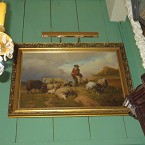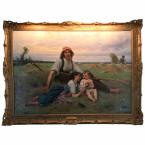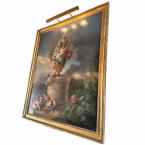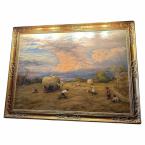














































19th C.
Orientalist Painting Pastel Arab and Camel, desert landscape fauna Flora . Beautiful
and fine 19th century orientalist Pastel painting of an Arab Man with his camel
traveling in the desert looking into the pink glow of the sun. In gilt frame. which depicts a group of people in the distance around their
tents , resting across a desert landscape with what must be the Badiya is a
region of desert or semi-desert and steppe of the Middle East, including parts
of southern Syria, eastern Jordan, northern Saudi Arabia, and western Iraq. People
of the region would be wrapped in light-colored clothing to
protect against the harsh desert weather conditions as depicted in this
painting.
The Artist has
masterfully painted this picture with the natural landscape with Desert Flowers
calligonum comosum that Helps Stabilize Sand Dunes. Amongst some other plants
that can survive the harsh temperature of the area, with some Date trees that
are full of fruits . Signs of Age as seen in the pictures, you are welcome to
see it in person or send your expert.
A dynamic
sense of movement that helps to create the illusion of spatial depth. The
desert landscape, as a result, appears vast and magnificent. �Crossing the
Desert� is also a technical masterpiece. The landscape and figures within it
are naturalistically portrayed, with every detail carefully rendered. This beautiful
orientalist painting will elevate your interior design with a splash of color. the
perfect magic touch to a library, a bedroom wall, living dining room. To
decorate the wall on top of a console or credenza. On top of a fireplace mantel
(fireplace) and entry way etc. 'Orientalism' refers to the representation of
the East in Western art which often blurred the line between fantasy and
reality. The Orientalist art movement reached its height during the 19th
century and is perhaps best known today for its production of impressive oil
paintings and works on paper. These paintings were popular in the 19th century,
as Europeans and North Americans increasingly turned their attentions to
cultures overseas. The works were mostly by male Western artists, made to
satisfy an enormous public interest in the lands of the Middle East and North
Africa.
Many artists
travelled to the places they depicted, whether Constantinople, Jerusalem, Cairo
or Marrakesh. Others travelled no further than Paris or Vienna, using a mixture
of photographs, props and imagination for inspiration. Recurring images
included everything from detailed sketches of everyday life to highly
imaginative scenes of the harem. Interest in Orientalism developed in tandem
with European colonial activity, which allowed soldiers, traders and artists
greater access to the places and peoples of these regions. An important function of Orientalist
painting was to create a visual record of places of interest. Such images were
aimed at a growing market of Europeans and North Americans who either visited
the Middle East and North Africa or were interested in the regions from afar.
Travel was made easier by steamships and trains, so paintings tended to focus
on cities, such as Constantinople, Cairo and Marrakesh, the arrival points for
artists and their potential customers alike. Some images depicted sites of religious
importance, both Christian and Muslim, while others captured the ancient sites
of pre-Islamic history
The absence
of a condition statement does not imply that the lot is in perfect condition or
completely free from wear and tear, imperfections or the effects of aging. To
sending your expert to create an independent Condition report , by appointment
only at la maison francaise antiques.
Any condition statement given, as a courtesy to a client, is only an
opinion and should not be treated as a statement of fact. Lamaisonfrancaise,
Inc. shall have no responsibility for any error or omission.
















Dimensions: Height: 46 in (116.84
cm)Width: 58.5 in (148.59 cm)Depth: 2.5 in (6.35 cm)
SOLD
A beautiful large and important masterpiece by Francois
Alfred Delobbe.
A similar artwork old master was sold April 18 2008 at
Sotheby's for $181,000.00 + 20%
Delobbe's two most powerful inspirations were his deep
connection to the French countryside and William Bouguereau, his teacher at the
�cole des Beaux-Arts. Born in Paris and absorbed in his studies for so many
years, the young artist had few opportunities to escape the city. It was not
until Delobbe journeyed to Concarneau, the native home of his friend and fellow
artist Alfred Guillou, that he began to explore Brittany's rocky fields and
ancient villages. While the region was painted by many of Delobbe's contemporaries,
most famously Jules Breton, Delobbe's Parisian upbringing perhaps made him
particularly sensitive to the effects of the open skies, verdant fields, and
sweeping, sandy beaches. Most of his traveling took place in spring and summer,
and he used the plein air sketches completed then during the winter in his City
Studio. Many of his favorite models came from the areas around Beuzec-cap-Sizun
and Lanriec,
As with his mentor's canvases, Delobbe's smooth brushwork
erases the presence of the painter and creates a balance between immobile,
static form and rich surface details, textures, and colors. Visual evidence
that a rustic, rural way of life remained, such portraits eased late nineteenth
century anxieties about France's growing industrialization. There is a
naturalistic truth to Delobbe's representation of the Characters, the skin
slightly reddened by rough winds and harsh sun, taking a break on a pile of Hay
by her infant and older daughter. Almost effortlessly, from her tool to the
back right side, while on her lap rests a large sifting tool. While this
process was notoriously labor-intensive, Delobbe's working woman reveals little
of the effort involved. With her stoic stance and calm expression the artist
creates an epic figure to join the ranks of Breton's strong-armed field hand in
or the maid busy haying in Julien Dupr�'s The Harvester (figs 2, 3). In her
solemnity, Delobbe's sifter becomes an icon of rural labor, her powerful
strength and work never ceasing, her connection to the land monumental, yet
sensitively portrayed.
Height: 20.25 Inches Width 24.5 Inches and thickness 1.5
Inches
At first look, desert habitats might appear harsh and
desolate with lack of rain and high temperatures . On the contrary, Cactus
plants store water and are home to different desert animals.
The desert landscape is wildly varied � shimmering white
sand dunes, natural rock arches, craters from volcanic eruptions, canyons with
layers of red, green, pink, yellow rocks, mountainous rock formations two
billion years old. Desert oases are filled with lush greenery.
In spring, after winter rains, the deserts bloom with
colorful wildflowers such as depicted in this beautiful work. February to April
is the ideal time when wild flowers are in bloom � red ocotillos, orange
poppies, purple lavender, lupine, heliotrope and sand verbena.
it's a stunning piece to add to your special collection, add
a touch of color and charm to your home. very decorative and versatile, it can
go in a bedroom a living room , office ,
entry . or simply mounted on top of your fireplace as a focal point. The frame
is beautiful with some cracks and losses as seen in the pictures, overall good
condition. Antique Dealer West Hollywood CA Melrose Ave La Cienega Blvd. This
painting is timeless and helps you dream and relax. it can be in a traditional
d�cor as well as a farm, a winery , a modern house , midcentury.
A great gift idea for a house warming, or to add to your
collection of unique beautiful happy Artwork.
Height: 20.25 Inches Width 24.5 Inches and thickness 1.5
Inches


Height: 64.5 in (163.83 cm)Width: 55 in (139.7 cm)Depth: 2
in (5.08 cm)
Distinguished by remarkable facility, exuberance, and
hedonism where pleasure plays a central role Psychological or motivational
hedonism claims that human behavior is determined by desires to increase
pleasure and to decrease pain . Romantic,
inspiring , uplifting tableau of a beautiful dog sitting by a Summer compagne hat
ornate with flowers and ribbon calling for the spring season , at the base of a
carved stone pedestal with an Urn mounted and decorated with an ocean of
flowers. The perfect romantic touch of the love for animals throughout history .
Original Hand carved wood Gilt frame.
To mount in a drawing room , Library , bedroom , entryway on
top of a console or chest of drawers. Very decorative and colorful. It will be
a fantastic touch on top of a mantle fireplace surround instead of the trumeau
. Art Gallery Antique Dealer Los angeles
, west Hollywood Melrose Ave La Cienega Blvd. A gift idea for a house warming
for someone special . As seen in the pictures , some work was done over the
centuries frame canvas. Cracks losses etc . adding even more charm to this
painting.

Measures: Height 21" x 26" width. Dimensions:
Height: 21 in (53.34 cm)Width: 26 in (66.04 cm)Depth: 1.5 in (3.81 cm)
Landscape Scene
Country Scene End of Summer Painting Oil on Canvas wood Framed. Good Size
Artwork , fall season skies depicting a rural country Farm and the field of
Hay. This painting is a charming picture, a snap shot of a beautiful peaceful
of the time past, the artist has managed to capture the uniqueness of the cold
light on a warm bright day. The autumnal colors of the scene are also
excellently rendered, and one can virtually single out the little purple flowers
that flank the way between the Stacks, which have been depicted with precision.
This beautiful painting is Has a Gilded wood Frame. As seen
craquelures, small losses but overall
good condition, Wood frame some cracks losses as seen. To mount in a drawing
room , Library , living , bedroom , entryway on top of a console or chest of
drawers. A great addition to your collection,
Art Gallery Antique Dealer West Hollywood Melrose Ave La Cienega Blvd. A
gift idea for a house warming for someone special or an office. Very decorative
and colorful. It will be a fantastic touch on top of a mantle fireplace
surround instead of the trumeau .
Measures: Height 21" x 26" width. Dimensions:
Height: 21 in (53.34 cm)Width: 26 in (66.04 cm)Depth: 1.5 in (3.81 cm)
Materials and Techniques: Canvas,Hand-Painted
Place of Origin: Europe
Period: Early 20th Century
Date of Manufacture: 1910
Condition: GoodWear consistent with age and use.

Dimensions: Height: 98 in (248.92 cm)Width: 106 in (269.24 cm)Depth: 2 in (5.08 cm)
Pair of 18th Century Very Large Oil on Canvas Panels framed
Wall mount Art LA CA . Very RARE 18th century very large and impressive pair of
French / Continental painted oil on canvas panels , fit for Grand Estates .
Outstanding Colors and design. Each panel have Two
medallions and each representing Putties at play. On one we have the little
Angels amorini representing cupids playing in the Clouds the game of Love heart
Target with bow and Arrow. Represented with very beautiful figures and
incredible face expression, surrounded by a wreath. The 2nd
medallion representing A putto Painter by the side of another winged friend ,
both putti in a work of art depicted as a chubby male children both winged . The
Artist of the two is represented with an older face expression, possibly the
painter depicting himself in it.
On the 2nd panel, the 1st medallion
representing the little winged angels At work in the fields, representing
nature, hard work, and a clear representation that we reap what we sow, and in
this case, they are reaping the rewards of the hard work. The 2nd
medallion on that panel with Two Amorini one at sleep and protected by the
other Amorini bearer of light. Floating in the skies above the clouds.
Celebrations Garland all throughout with flowers , bows,
nature, leaves , pedestals and urns ornate with the generosity of nature,
overflowing with the wealth and blessings. Imposing Huge panels that will
Elevate your interior design. Continental panels that can go in a living or
dining room, grand entrance hallways , a library , a high end office.
Antique dealer Los Angeles CA West Hollywood Melrose Ave La
Cienega blvd. , interior design element , high end decor . Very Large Scale art
with a beautiful Hand made Frame .
Dimensions: Height: 98 in (248.92 cm)Width: 106 in (269.24
cm)Depth: 2 in (5.08 cm)
Museums Include:
Victoria and Albert Museum : Rocky Promontory / The Harvest
Moon / Landscape, Evening / A Coming
Storm Glasgow Museums Resource Centre (GMRC) / Landscape, Driving Cattle.
Museum of London : Collins's Farm, North End, Hampstead,
London
At Yale Center for British Art : John Linnell, 1792�1882, A
Finished Study for 'Reaping', 1858
New York Metropolitan
and National Portrait Gallery.
Comparable art work sold at Auctions:
1-
John Linnell (1792-1882) 49 x 73 in. The Return of Ulysses London 19 February 2003 Price
realized GBP 171,650 + 25% Fee TOTAL $302,000
2-
SMALL Art WORK John Linnell (1792-1882) SMALL
11 x 13 7/8 in. The potato
field - Isle of Wight Price realized GBP 50,000 Sold July 2017
3-
John Linnell (London 1792-1882) 39� x 54� in Reapers at Noon June 2009 Price realized
USD 206,500+ 25% TOTAL $258,000 Dollars
John Linnell was an English engraver, and portrait and
landscape painter. He was a naturalist and a rival to the artist John
Constable. He had a taste for Northern European art of the Renaissance,
particularly Albrecht D�rer. He also associated with Edward Thomas Daniell, and
with William Blake, to whom he introduced the painter and writer Samuel Palmer
and others of the Ancients.
John Linnell was born in Bloomsbury, London on 16 June
1792., where his father was a carver and gilder. He was in contact with artists
from an early age, and by the age of ten was drawing and selling portraits in
chalk and pencil. His first art teacher was the American-born artist Benjamin
West, and he spent a year in the house of the painter John Varley, where
William Hunt and William Mulready were also pupils, and made the acquaintance
of Shelley, Godwin and others. In 1805 he was admitted to study at the Royal
Academy, where he obtained medals for drawing, modelling and sculpture. He was
trained as an engraver, and executed a transcript of Varley's "Burial of
Saul."
In 1808, the 16-year-old Linnell moved into the house of the
painter William Mulready, whose wife had accused him of infidelity with both
other women and boys. Linnell's association with Mulready may have caused the
breakup of Mulready's marriage.
In later life Linnell occupied himself with the burin,
publishing, in 1833, a series of outlines from Michelangelo's frescoes in the
Sistine Chapel, and, in 1840, superintending the issue of a selection of plates
from the pictures in Buckingham Palace, one of them, a Titian landscape, which
he engraved in mezzotint. At first he supported himself mainly by miniature
painting and execution of larger portraits, such as the likenesses of Mulready,
Richard Whately, Peel and Thomas Carlyle. Several of his portraits he engraved
in line and mezzotint.
He painted many subjects like the "St John
Preaching," the "Covenant of Abraham," and the "Journey to
Emmaus," in which, while the landscape is usually prominent the figures
are of sufficient importance to supply the title of the work. But it is mainly
in connexion with paintings of pure landscapes that his name is known. His
works commonly deal with some scene of typical uneventful English landscape,
which is made impressive by a gorgeous effect of sunrise or sunset. They are
full of true poetic feeling, and are rich and glowing in colour.
Linnell commanded large prices for his pictures, and about
1850 he purchased a property at Redhill, Surrey, where he lived till his death
on 20 January 1882, painting with unabated powers until within the last few
years of his life. He devoted himself to painting landscapes notably of the
North Downs and Kentish Weald. His leisure was occupied with a study of the
Bible in the original, and he published several pamphlets and treatises of
Biblical criticism. Linnell was one of the best friends and kindest patrons of
William Blake. He gave him the two largest commissions he received for single
series of designs��150 for drawings and engravings of The Inventions to the
Book of Job, and a like sum for those illustrative of Dante Aligheri.
He was a friend of the painter Edward Thomas Daniell. A blue
plaque commemorates Linnell at Old Wyldes' at North End, Hampstead. The plaque
mentions that William Blake stayed with Linnell as his guest.
Subject Terms in this art work: agriculture | animal |
clouds | corn | cutting | dog (animal) | farm | farming | farmland | fields |
gathering | harvest | hay | labor | laborers | landscape | men | reapers |
rural | study (visual work) | summer | woman | work
it's a stunning piece to add to your special collection, add
a touch of color and charm to your home. very decorative and versatile, it can
go in a bedroom a living room , office ,
entry . or simply mounted on top of your fireplace as a focal point. The frame
is beautiful with some cracks and losses as seen in the pictures, overall good
condition. Antique Dealer West Hollywood CA Melrose Ave La Cienega Blvd. This
painting is timeless and helps you dream and relax. it can be in a traditional
d�cor as well as a farm, a winery , a modern house , midcentury.
A great gift idea for a house warming, it�s a Rare collector�s
painting to add to your special collection of unique beautiful happy Artwork. The
absence of a condition statement does not imply that the lot is in perfect
condition or completely free from wear and tear, imperfections or the effects
of aging. To sending your expert to create an independent Condition report , by
appointment only at la maison francaise antiques. Any condition statement given, as a courtesy
to a client, is only an opinion and should not be treated as a statement of
fact. Lamaisonfrancaise, Inc. shall have no responsibility for any error or
omission. We have many additional pictures of the back and under the blue
light. No apparent flaking or losses but
as you can see the cracks which is normal after 150 years. You are welcome to
send your experts.















































